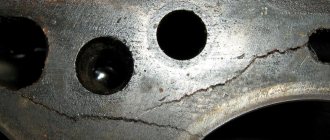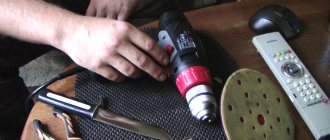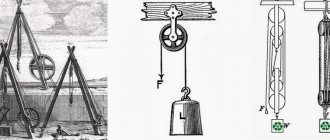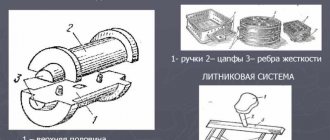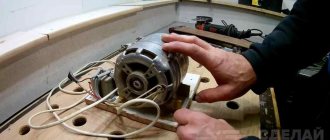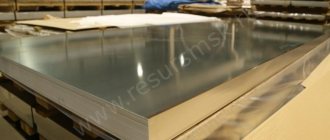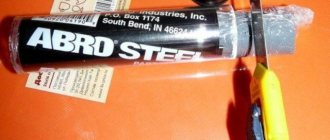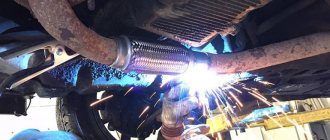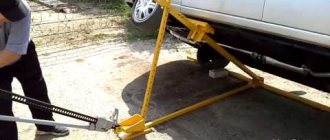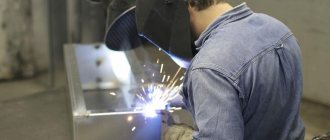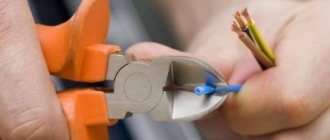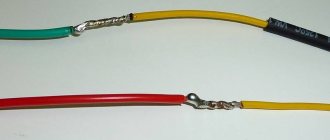There are different types of car engine repairs. You can simply use recovery after the breakdown of some internal and peripheral parts. And it is possible to restore after serious damage. These types of breakdowns include cracks in the cylinder block, chips in functional areas of the unit and various other features. With such breakdowns, it is simply impossible to operate the power unit, otherwise it may rupture during the process of pressurizing the chambers. There are two options for getting out of the situation. The first is replacing the damaged part. You need to select a suitable version of the engine block or a specific part; this can be done by disassembling, but with the help of a good specialist. This way you can make a really high-quality selection and buy reliable spare parts for restoration.
The second option is argon welding. Many owners of cars with damaged power units perform argon welding. This is a fairly high-quality process of connecting aluminum alloy parts to each other. However, this is not the best solution for load-bearing main engine parts. If the cylinder block is cracked, it is better to buy a new one. Here welding will not be an appropriate solution to the problem. This is one of the most expensive options for car breakdowns, but sometimes you can get by with more or less affordable costs. It all depends on the type and location of the crack, as well as a number of other features. It is important to complete all tasks really efficiently in order to restore all parts and obtain high reliability of the power unit.
Replacing the cylinder block and abandoning welding is the right decision
Any welding, even by the most professional performer, will not be as high quality as installing a new cylinder block. When there is a crack in this unit, the component parts of the unit quickly break down and everything fails. Even with professional welding, it is impossible to maintain all factory dimensions down to the last micron. The cylinder block is replaced as follows:
- Based on the make and model of the engine, the specialist searches for spare parts, selects all peripheral parts that will also have to be changed, and forms a budget;
- Also added to this budget is the cost of work, which each master evaluates in his own way, but it is better to contact a professional car service station;
- Next, the engine is disassembled, the problem and its effect on all other parts, such as pistons, connecting rods, rings and seals in the unit, are studied;
- a new cylinder block is installed, the necessary parts are assembled in the right place, and at each stage several checks are performed, which proves the quality of the part;
- After assembly, it is necessary to diagnose the power unit in different planes, then test drive the car with an understanding of all extraneous sounds and noises in the engine.
If a used cylinder block is being installed, special care must be taken during the engine testing and inspection processes. However, with professional selection of the part, no negative features of the operation of the power unit should arise. That is why replacement is the optimal process for such a breakdown. But welding is not always suitable, even if done professionally.
Features of welding internal combustion engine blocks at home
At home, blocks are brewed using an inverter and electrodes with a high graphite content. A protective atmosphere (argon) is supplied, which prevents contact of the melt with air. There are repair technologies using filler wire, which is fed into the arc burning zone. To protect from atmospheric air, carbon dioxide is supplied to the working area. The technique allows you to reduce the heating temperature of the part, avoid deformation and the formation of new cracks.
Recommended reading: Underwater welding
Modern technologies for welding aluminum with argon
There are many processes in a modern car that can be performed using argon. It is quite easy to restore wheels made of light alloy materials using this technology. But the basis is the repair of engine housings and blocks, as well as gearboxes. In the process of welding engine elements with argon, the following important tasks are performed, which are performed only by specialists:
- research and preparation of each element for welding work, cleaning the surface and searching for additional material if necessary, to seal the hole;
- preparing the site according to safety measures, we are talking about welding at very high temperatures with a certain risk of damage to people and objects around;
- implementation of the welding process itself, with careful supervision of all surrounding parts, very careful execution of the main necessary task;
- the use of additional compounds for surface treatment to avoid its oxidation and other unpleasant processes after all welding work has been completed;
- cleaning the welding site if necessary to obtain a smooth surface that meets the manufacturer’s technological requirements for operation.
It is worth recognizing that welding internal damage to the cylinder block does not make sense. Even if the technician manages to remove certain damage with argon, it will not be possible to restore the normal mirror surface of the inside of the engine. Such damage can only be cured by replacing the entire block or engine. However, there are craftsmen who perform such services, offering argon welding in any conditions.
Repairing the cylinder block part 6 - glue instead of welding
(published in abbreviation)
ALEXANDER KHRULEV, candidate of technical sciences?
“I missed the oil” - this is how one of the drivers described his case. If you missed it, it means you didn’t check it in time. And the engine was left without oil. The consequences are clear: the connecting rod bearing “knocked”. It ended up that the connecting rod broke off and, falling between the crankshaft and the block wall, punched a good hole in the cylinder block.
This block, of course, needs to be changed. But it costs money, and a lot of it. So, although there are options, they do not always provide a real way out of the situation.
But what if you don’t change the block? Should I try to repair it? Well, it’s a good thing, but it’s not easy, requiring knowledge and some experience.
To cook or not to cook?
In principle, it is possible to repair a cylinder block with any damage. The whole question is how economically justified it is.
Of course, before starting to correct such complex damage as holes, it is necessary to outline a repair technology. The most important question is how to seal the hole. The complexity of the work, the need for special equipment and tools, and ultimately the reliability of the engine after repair depend on this.
The traditional method of repairing holes in the cylinder block is welding. However, it is difficult to simply take and weld a hole. Local heating in the weld zone always leads to the occurrence of large stresses when the block cools. And this is dangerous - cracks may form. But even if there are no cracks, the strong heating will still not go in vain, and after cooling the block may turn out to be deformed.
Of course, the result greatly depends on the qualifications of the welder and the equipment used. For example, if the block is heated before welding and then slowly cooled, the stresses will be noticeably reduced. This means that deformations will decrease and cracks will most likely not appear. True, such a process requires a special oven, and this is not so cheap. By the way, good welding equipment is also not cheap. Welding has other disadvantages related to the materials from which the engine blocks are made. Thus, alloying elements present in the metal often interfere with obtaining a high-quality weld.
When the hole is welded, the strength and rigidity of the block, damaged as a result of the breakage, will be restored. But this does not mean at all that the repaired block will regain its former tightness. It must be checked and, if necessary, the seam must be additionally sealed, for example, using various adhesive compositions.
So it turns out that in many cases welding is a rather complicated and not the most successful method of repair. Which one is better? There is no definite answer, but there is still an alternative to welding.
How to seal a hole
So, the technology used should be accessible and inexpensive, that is, it should not require expensive equipment, tools and materials; it must be performed by semi-skilled personnel and ensure high engine reliability after repair. All of the above requirements are fully satisfied by the repair method using adhesive compositions.
Are you surprised? In vain. The technology of gluing blocks has long been tested and is successfully used by a number of specialized engine repair shops.
Any adhesive composition, like welding, cannot be applied simply, as they say, directly. It is imperative to comply with the requirements, which have already been worked out quite well. Let us briefly formulate the task: it is necessary to repair the hole in the block, ensuring high strength and tightness of the wall after repair. Its solution is available to any workshop or service station.
As always, we need to start with preparation. It is necessary to thoroughly clean the surface around the hole (both inside and outside the block) to a width of 20-25 mm. Next, you should cut and fit the linings from sheet steel with a thickness of 0.7-0.8 mm. In order to close the hole with an overlap of 15-20 mm on both sides - inside and outside. Since the shape of the overlays will most likely be complex, repeating the “relief” of the block’s surface, it is better to first make cardboard templates, and only then cut out the overlays using them.
The linings are adjusted into place by tapping them with a hammer to ensure their precise fit to the block. Where there is a complete fit, holes are marked and drilled. To do this, the overlay is pressed against the block, and with a 5.0-5.2 mm drill, through drillings are made through the overlay in the wall of the block. The holes should be located evenly along the contour of the hole with a pitch of 40-50 mm. The holes in the plates are drilled to 6.5 mm, and M6 threads are cut into the holes of the block. Where the walls of the block are thin enough (less than 8-10 mm), you can drill holes in the block up to 6.5 mm, and then use one bolt to tighten both linings - both outside and inside.
It would be useful to pre-assemble the structure - install and tighten all the bolts in order to check how the linings fit on the block and how the bolts are tightened. All that remains is to thoroughly clean the surfaces of the linings, degrease everything with acetone and proceed to the final stage of repair - applying the adhesive composition. What should I apply?
Indeed, the epoxy resin that was widely used in the past is no longer suitable today. For example, without filler it will leak out of the gaps between the pads and the block. Without a plasticizer, nothing will work either - the hardened resin will crack, since the cylinder block constantly experiences heating-cooling cycles, leading to stresses that are dangerous for the resin.
Compositions such as “cold welding” are more successful. Their base, as a rule, is the same, epoxy, but the properties due to additives are better - strength, ductility, and adhesion. Some of these materials can withstand high temperatures - up to 250-3000C, which will not be superfluous for the engine.
But from the available options, we chose the composition of the American company Belzona.
For the repair of cast iron parts, the company's program includes compositions with fine cast iron chips, ideal for cylinder blocks. And, of course, many years of experience in using these compositions to repair blocks is also worth a lot. In our opinion, the only drawback of Belzona materials is the relatively high price (more than $100 per kilogram).
Having mixed the components in the required proportion (1:3 by volume), apply them to the block wall along the contour of the hole and press one of the pads. After this, the hole is filled with the composition and a second overlay is installed. There should be enough composition between the linings that when the bolts are tightened, some of it is squeezed out along the entire contour of the linings.
When the composition has hardened, all that remains is to cut off the protruding part of the bolts (for aesthetic reasons or if they interfere with something) and paint the block.?
www.motornn.ru
When does it not make sense to weld with argon?
Often during the operation of a car, it becomes necessary to change the sensor in the engine housing or spark plugs. It may well turn out that these elements are too tight. In this case, the master or owner may apply excessive force and simply break off a piece of the unit. If this was done at the place where the spark plug was installed, you will have to buy a new block. When attempting to weld, the following processes will occur:
- the technician will restore the damaged area as carefully as possible, but the seat diameter can no longer be made ideal for the candle;
- you can use the option of melting, and then drilling and cutting the required thread, but it is also impossible to maintain the required installation height of the candle;
- if we are talking about a sensor, it is also simply melted and not used in the future, because otherwise you will have to perform incredibly difficult work to restore the installation site;
- if there is a crack in the body itself from the outside, you can be sure that there is a crack on the inside, so it can only be welded in certain situations that a specialist knows about;
- unprofessional argon welding will bring big problems, in this case it is better not to do any work with a broken cylinder block, but simply buy a new one.
Welding with an argon mixture occurs using a tungsten electrode, which heats up to a temperature of about 4000 degrees at maximum mode. This requires not only increased caution, but also fairly high professionalism. Simply place the electrode in the wrong spot, and it will simply make another hole instead of welding the necessary elements of your engine.
ICE welding methods
Several technologies are used to restore damage:
- hot processing;
- semi-hot exposure;
- welding without preheating.
Recommended reading: Why do you need a welding log?
Types of welding used in repairs.
hot
The hot process means welding with pre-heating of the workpiece with a gas torch to +600°...+700°C. After the seam is formed, the block is slowly cooled in an oven, minimizing the risk of bleaching (the appearance of a hard and brittle phase) and the formation of gas pores. To perform the work, special equipment is required, so the technology is not used in domestic conditions. The seam is characterized by increased mechanical strength (if the requirements are met). It is allowed to repair damage in hard-to-reach areas.
Semi-hot
For massive body parts, complete heating is difficult, so they are processed using semi-hot welding technology. The area around the seam is heated to a temperature of +300°...+400°C, and then cooled evenly. Increased wall thickness and greater weight of the structure reduce the risk of new cracks due to thermal stress or the formation of white cast iron crystals. The technique is designed for the use of special equipment and is not used in domestic conditions.
Cold
To repair damage, electrodes with rods containing graphite and alloying additives are used. Additional elements bind the carbides (a process called spherization) and prevent the development of new cracks. There are electrodes for cold welding of cast iron and alloys based on iron, copper and nickel. The surface of the tool is coated with a layer of graphite-based flux, which saturates the material with carbon.
Welding an engine with argon and subsequent sale - we are clogging up the car market
The attitude of Russian people towards the automobile market is simply surprising. Many people sell their cars, realizing that in two days they will have an irreparable problem and will have to replace expensive components and assemblies. It is enough to simply understand how much anger and hatred the buyer will feel towards you, so as not to make such a mistake. If the cylinder block in your car is cracked, you should work around the situation as follows:
- replace the unit with a used, but high-quality one, get more money from the leisurely sale of the car without special discounts and with confidence in the high quality of the car;
- replace the cylinder block with a new one and continue driving the car without selling it, enjoying the fairly high quality of the revived power unit;
- indicate in the sales advertisement that the car is damaged, there are certain problems that can be solved for a certain amount, which will result in a discount;
- when meeting with a potential buyer, honestly tell them that there is a problem with the engine that needs to be solved urgently, and reveal your readiness to concede the selling price;
- weld the engine with argon, and then, when selling, honestly admit this and show the place of welding, this will relieve you of any responsibility for the further behavior of the unit.
It is often possible to gain no more than a few hundred dollars by concealing all the details of car repairs from the buyer. And this amount is definitely not worth it to continue to clog up the automotive market with not entirely suitable equipment. Such decisions can also be disastrous for you if the buyer decides to look into the whole situation. However, for now there is no need to expect a civilized market in Russia. We invite you to look at more or less high-quality restoration of microcracks using argon:
Welding an engine block with argon - does it make sense?
There are different types of car engine repairs. You can simply use recovery after the breakdown of some internal and peripheral parts. And it is possible to restore after serious damage. These types of breakdowns include cracks in the cylinder block, chips in functional areas of the unit and various other features. With such breakdowns, it is simply impossible to operate the power unit, otherwise it may rupture during the process of pressurizing the chambers. There are two options for getting out of the situation. The first is replacing the damaged part. You need to select a suitable version of the engine block or a specific part; this can be done by disassembling, but with the help of a good specialist. This way you can make a really high-quality selection and buy reliable spare parts for restoration.
The second option is argon welding. Many owners of cars with damaged power units perform argon welding. This is a fairly high-quality process of connecting aluminum alloy parts to each other. However, this is not the best solution for load-bearing main engine parts. If the cylinder block is cracked, it is better to buy a new one. Here welding will not be an appropriate solution to the problem. This is one of the most expensive options for car breakdowns, but sometimes you can get by with more or less affordable costs. It all depends on the type and location of the crack, as well as a number of other features. It is important to complete all tasks really efficiently in order to restore all parts and obtain high reliability of the power unit.
Let's sum it up
As you can see, the cylinder block is welded with argon most often for sale. This is not the most reliable option for repairing a power plant. But there are masters who can do everything quite efficiently. Often, after a visit to them, the owners decide to sell the car, as they are constantly worried about the presence of handicraft interference in the operation of the engine. Any sound becomes scary, it seems that the engine is now going to shatter into small pieces. Therefore, when repairing a car for your own further use, it is much better and easier to perform a normal repair with replacement of the cylinder block.
When making repairs for sale, it is better to refuse any work altogether, simply discounting the price to the buyer for the amount of repair work. If the new owner wants to cook the engine with argon, that will be his problem. You will come out of this situation fairly honestly with an untarnished reputation. You should not carry out cheap argon welding in a garage car service, and then quickly go to the car market in the hope of selling the car and forgetting about all these problems. Through mutual scams, car owners have already made the car market a dangerous place where they can lose all their money. How do you feel about repairing unit housings and gearboxes using argon welding?
Approximate prices for services
| № | Name of works | Number of standard hours | Standard hour cost (RUB) | Total cost (RUB) |
| 1 | Welding the cylinder block | 24,8 | 1200 | 29760 |
| 2 | Local painting from | 2,8 | 1200 | 3360 |
| 3 | Door repair. | 2,8 | 1200 | 3360 |
| 4 | Engine painting | 24,8 | 1200 | 29760 |
| 5 | Installation on a slipway. | 1,3 | 1200 | 1560 |
| 6 | Painting rear lights, pair | 2,8 | 1200 | 3360 |
| 7 | Painting the mirror body | 1,3 | 1200 | 1560 |
| 8 | Local painting of parts from | 2,8 | 1200 | 3360 |
| 9 | Exclusive (non-standard) painting | 3,8 | 1200 | 4560 |
| 10 | Repair and replacement of spar | 7,8 | 1200 | 9360 |
Please note that this online resource (including the indicated prices for services) is for informational purposes only and under no circumstances constitutes a public offer as defined by the provisions of Article 437 (2) of the Civil Code of the Russian Federation. The cost of work varies depending on the make of the car, its age and technical condition.
Equipment and materials for welding
Work must be carried out in a protective suit.
To carry out the work you will need:
- standard welding machine or inverter with the function of adjusting the current in the circuit;
- ferronickel electrodes (for example, model 855 manufactured by Zeller);
- metal brush and hammer to remove scale and remaining protective coating;
- protective shield and welder's suit to prevent burns from flying drops of metal and scale.
Electrodes for welding automotive cast iron block
The main task of the welder when eliminating damage to cast iron parts is to obtain strong connections and prevent the appearance of new cracks. The electrode diameter, current value and arc length characterize the manual arc welding mode. Depending on the thickness of the welded metal, the diameter of the electrode is selected.
For welding a cast iron block , where the metal thickness is 4-8 mm, electrodes with a diameter of 3-4 mm are mainly used. The current value is selected at the rate of 30-40 amperes per millimeter of electrode diameter. For example, using the MNCh-2 electrode, the diameter of which is 3 mm, welding is carried out at a current value of 90A, and when using the OZCh-6 electrode, with a similar diameter, the current value is 80-100A. Welding cast iron with iron-kel electrodes differs from the technique of welding steel.
Additional Information
After completion of the work, the surfaces must be treated (for example, if any unit is being installed). In a workshop setting, a milling machine is used to level the plane; in a domestic situation, an angle grinder is used. At the same time, it is important not to damage the mating surfaces with high precision processing (for example, for installing a clutch bell, front cover or head).
Welding an automobile cylinder block requires a highly qualified worker. Mistakes made lead to a decrease in the strength of the assembly; with cyclic temperature changes (the part warms up to +90°...+95°C and cools down to ambient temperature), new cracks may appear. In case of a large area of damage, it is possible to install patches from a sheet of steel, which are welded into cast iron. The decision on the method of restoration and the feasibility of repair is made by the master, based on the qualifications and equipment available.
Source
What are internal combustion engine blocks
The engine cylinder block is cast from cast iron or aluminum alloy. The body has holes for liners or there is a monolithic insert with those for pistons. Inside the part there are ducts for antifreeze and oil; on the lower part there are beds for the crankshaft bearings. The unit absorbs force loads and has bosses for installing cushions necessary for installation in the engine compartment. On the outer part there is a platform on which the serial marking is stamped or otherwise applied (information about this is entered into the PTS and traffic police information databases).
Preparing the cylinder block for welding
Before carrying out welding work to repair the unit, it is necessary to thoroughly clean it of dirt, oil and other contaminants. Cracks and discontinuities identified on the block must be marked with chalk or other convenient means.
In order to avoid the growth of cracks, its edges must be drilled. Small cracks up to 5 mm can be welded without cutting the edges. Deeper cracks must be made with cutting edges.
The hole must not be made through, but only until a gap appears along the entire length of the crack. The crack prepared for welding should resemble a joint with a V-shaped bevel of the edges. This is done so that during welding all gases and impurities contained in the welding materials and base metal can escape to the surface of the weld.
Welding technology
When welding a cast iron engine block at home or in production, all specified points of the technology should be carefully followed.
- The surface is cleaned to a shine. This can be done using a metal brush.
- It is necessary to degrease the surface with solvents to remove oxidizing film and other chemical deposits.
- You should select the required flux and place it along the welding edge, at least throughout the first stage of the seam.
- Next, you need to heat the metal with a gas torch to the required temperature for several minutes, since welding on the fly is not recommended.
- When the metal reaches the desired temperature, you can begin to weld the metal. This should happen in small sections, approximately 10-15 cm at a time.
- When the seam is completed, you need to heat the metal for a few more minutes, gradually lowering the temperature to avoid rapid cooling and sudden changes.
- Check the quality of the resulting connections. In the home sphere this is done visually, but in production there are various professional methods of internal in-depth control.
